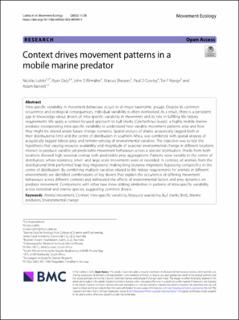| dc.contributor.author | Lubitz, Nicolas | |
| dc.contributor.author | Daly, Ryan | |
| dc.contributor.author | Filmalter, John D. | |
| dc.contributor.author | Sheaves, Marcus | |
| dc.contributor.author | Cowley, Paul D. | |
| dc.contributor.author | Næsje, Tor | |
| dc.contributor.author | Barnett, Adam | |
| dc.coverage.spatial | Southern Africa | en_US |
| dc.date.accessioned | 2023-06-05T13:32:35Z | |
| dc.date.available | 2023-06-05T13:32:35Z | |
| dc.date.created | 2023-05-26T12:43:27Z | |
| dc.date.issued | 2023 | |
| dc.identifier.issn | 2051-3933 | |
| dc.identifier.uri | https://hdl.handle.net/11250/3069974 | |
| dc.description.abstract | Intra-specific variability in movement behaviour occurs in all major taxonomic groups. Despite its common occurrence and ecological consequences, individual variability is often overlooked. As a result, there is a persistent gap in knowledge about drivers of intra-specific variability in movement and its role in fulfilling life history requirements. We apply a context-focused approach to bull sharks (Carcharhinus leucas), a highly mobile marine predator, incorporating intra-specific variability to understand how variable movement patterns arise and how they might be altered under future change scenarios. Spatial analysis of sharks, acoustically tagged both at their distributional limit and the centre of distribution in southern Africa, was combined with spatial analysis of acoustically tagged teleost prey and remote-sensing of environmental variables. The objective was to test the hypothesis that varying resource availability and magnitude of seasonal environmental change in different locations interact to produce variable yet predictable movement behaviours across a species’ distribution. Sharks from both locations showed high seasonal overlap with predictable prey aggregations. Patterns were variable in the centre of distribution, where residency, small- and large-scale movements were all recorded. In contrast, all animals from the distributional limit performed ‘leap-frog migrations’, making long-distance migrations bypassing conspecifics in the centre of distribution. By combining multiple variables related to life history requirements for animals in different environments we identified combinations of key drivers that explain the occurrence of differing movement behaviours across different contexts and delineated the effects of environmental factors and prey dynamics on predator movement. Comparisons with other taxa show striking similarities in patterns of intra-specific variability across terrestrial and marine species, suggesting common drivers. Animal movement, Context, Intra-specific variability, Resource availability, Bull sharks, Birds, Marine predators, Environmental change | en_US |
| dc.description.abstract | Context drives movement patterns in a mobile marine predator | en_US |
| dc.language.iso | eng | en_US |
| dc.rights | Navngivelse 4.0 Internasjonal | * |
| dc.rights.uri | http://creativecommons.org/licenses/by/4.0/deed.no | * |
| dc.subject | Animal movement | en_US |
| dc.subject | Context | en_US |
| dc.subject | Intra-specific variability | en_US |
| dc.subject | Resource availability | en_US |
| dc.subject | Bull sharks | en_US |
| dc.subject | Birds | en_US |
| dc.subject | Marine predators | en_US |
| dc.subject | Environmental change | en_US |
| dc.title | Context drives movement patterns in a mobile marine predator | en_US |
| dc.title.alternative | Context drives movement patterns in a mobile marine predator | en_US |
| dc.type | Peer reviewed | en_US |
| dc.type | Journal article | en_US |
| dc.description.version | publishedVersion | en_US |
| dc.rights.holder | © 2023 The Authors | en_US |
| dc.subject.nsi | VDP::Zoologiske og botaniske fag: 480 | en_US |
| dc.subject.nsi | VDP::Zoology and botany: 480 | en_US |
| dc.source.volume | 11 | en_US |
| dc.source.journal | Movement Ecology | en_US |
| dc.identifier.doi | 10.1186/s40462-023-00390-5 | |
| dc.identifier.cristin | 2149571 | |
| dc.relation.project | Norges forskningsråd: 287015 | en_US |
| dc.source.articlenumber | 28 | en_US |
| cristin.ispublished | true | |
| cristin.fulltext | original | |
| cristin.qualitycode | 1 | |

